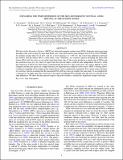| dc.contributor.author | Allegrini, F. | |
| dc.contributor.author | Bzowski, M. | |
| dc.contributor.author | Dayeh, M. A. | |
| dc.contributor.author | DeMajistre, R. | |
| dc.contributor.author | Desai, M. I. | |
| dc.contributor.author | Funsten, H. O. | |
| dc.contributor.author | Fuselier, S. A. | |
| dc.contributor.author | Janzen, Paul H. | |
| dc.contributor.author | Kubiak, M. A. | |
| dc.contributor.author | McComas, David J. | |
| dc.contributor.author | Reisenfeld, D. B. | |
| dc.contributor.author | Schwadron, N. | |
| dc.contributor.author | Vanderspek, Roland K | |
| dc.date.accessioned | 2015-02-25T22:50:12Z | |
| dc.date.available | 2015-02-25T22:50:12Z | |
| dc.date.issued | 2012-04 | |
| dc.date.submitted | 2011-12 | |
| dc.identifier.issn | 2041-8205 | |
| dc.identifier.issn | 2041-8213 | |
| dc.identifier.uri | http://hdl.handle.net/1721.1/95647 | |
| dc.description.abstract | The Interstellar Boundary Explorer (IBEX) has observed energetic neutral atom (ENA) hydrogen emissions from the edge of the solar system for more than three years. The observations span energies from 0.01 to 6 keV FWHM. At energies greater than 0.5-6 keV, and for a travel distance of ~100 AU, the travel time difference between the slowest and the fastest ENA is more than a year. Therefore, we construct spectra including the effect that slower ENAs left the source at an earlier time than faster ones. If the source produces a steady rate of ENAs and the extinction does not vary, then we expect that the spectral shape would be time independent. However, while the extinction of ENAs has been fairly constant during the first two and a half years, the source appears to have changed, and thus the spectra at a single time may not represent the conditions at the source. IBEX's viewing allows continuous sampling of the ecliptic poles where fluxes can be continuously monitored. For a given source distance we construct spectra assuming that the measured ENAs left the source at roughly the same time. To accomplish this construction, we apply time lag corrections to the signal at different ENA energies that take into account the travel time difference. We show that the spectral shape at the poles exhibits a statistically significant change with time. | en_US |
| dc.description.sponsorship | United States. National Aeronautics and Space Administration. Explorers Program (IBEX Project) | en_US |
| dc.description.sponsorship | Poland. Ministry of Science and Higher Education (Grant NS-1260-11-09) | en_US |
| dc.language.iso | en_US | |
| dc.publisher | IOP Publishing | en_US |
| dc.relation.isversionof | http://dx.doi.org/10.1088/2041-8205/749/2/l41 | en_US |
| dc.rights | Article is made available in accordance with the publisher's policy and may be subject to US copyright law. Please refer to the publisher's site for terms of use. | en_US |
| dc.source | American Astronomical Society | en_US |
| dc.title | EXPLORING THE TIME DISPERSION OF THE IBEX -HI ENERGETIC NEUTRAL ATOM SPECTRA AT THE ECLIPTIC POLES | en_US |
| dc.type | Article | en_US |
| dc.identifier.citation | Allegrini, F., M. Bzowski, M. A. Dayeh, R. DeMajistre, M. I. Desai, H. O. Funsten, S. A. Fuselier, et al. “ EXPLORING THE TIME DISPERSION OF THE IBEX -HI ENERGETIC NEUTRAL ATOM SPECTRA AT THE ECLIPTIC POLES .” The Astrophysical Journal 749, no. 2 (April 2, 2012): L41. © 2012 The American Astronomical Society | en_US |
| dc.contributor.department | MIT Kavli Institute for Astrophysics and Space Research | en_US |
| dc.contributor.mitauthor | Vanderspek, Roland K. | en_US |
| dc.relation.journal | Astrophysical Journal. Letters | en_US |
| dc.eprint.version | Final published version | en_US |
| dc.type.uri | http://purl.org/eprint/type/JournalArticle | en_US |
| eprint.status | http://purl.org/eprint/status/PeerReviewed | en_US |
| dspace.orderedauthors | Allegrini, F.; Bzowski, M.; Dayeh, M. A.; DeMajistre, R.; Desai, M. I.; Funsten, H. O.; Fuselier, S. A.; Janzen, P. H.; Kubiak, M. A.; McComas, D. J.; Reisenfeld, D. B.; Schwadron, N.; Vanderspek, R. | en_US |
| mit.license | PUBLISHER_POLICY | en_US |
| mit.metadata.status | Complete | |
